AMD Ryzen Threadripper 7980X & 7970X Review: Revived HEDT Brings More Cores of Zen 4
by Gavin Bonshor on November 20, 2023 9:00 AM EST- Posted in
- CPUs
- AMD
- HEDT
- ThreadRipper
- Zen 4
- Threadripper 7000
- TRX50
TR 7000 vs. Intel: Power and Compile
Our previous sets of ‘office’ benchmarks have often been a mix of science and synthetics, so this time, we wanted to keep our office and productivity section purely based on real-world performance. We've also incorporated our power testing into this section. Given the nature and target market of the Ryzen Threadripper 7000 series, we've opted to focus on tasks such as compiling.
We are using DDR5-5200 RDIMM memory on the Ryzen Threadripper 7980X and 7970X as per JEDEC specifications. For Intel's Xeon W9-3495X, we are using DDR5-4800 RDIMM memory as per Intel's JEDEC specifications. It should be noted that both platforms are run with their full allocation of memory channels, e.g., TR7000 in 4-channel and Sapphire Rapids in 8-channel.
Below are the settings we have used for each platform:
- DDR5-5200 RDIMM - AMD Threadripper 7000
- DDR5-4800 RDIMM - Intel Xeon Sapphire Rapids WS
- DDR5-5600B CL46 - Intel 14th Gen
- DDR5-5200 CL44 - Ryzen 7000
Power
The nature of reporting processor power consumption has become, in part, a bit of a nightmare. Historically the peak power consumption of a processor, as purchased, is given by its Thermal Design Power (TDP, or PL1). For many markets, such as embedded processors, that value of TDP still signifies the peak power consumption. For the processors we test at AnandTech, either desktop, notebook, or enterprise, this is not always the case.
Modern high-performance processors implement a feature called Turbo. This allows, usually for a limited time, a processor to go beyond its rated frequency. Exactly how far the processor goes depends on a few factors, such as the Turbo Power Limit (PL2), whether the peak frequency is hard coded, the thermals, and the power delivery. Turbo can sometimes be very aggressive, allowing power values 2.5x above the rated TDP.
AMD and Intel have different definitions for TDP that are, broadly speaking, applied the same. The difference comes from turbo modes, turbo limits, turbo budgets, and how the processors manage that power balance. These topics are 10000-12000 word articles in their own right, and we’ve got a few articles worth reading on the topic.
- Why Intel Processors Draw More Power Than Expected: TDP and Turbo Explained
- Talking TDP, Turbo and Overclocking: An Interview with Intel Fellow Guy Therien
- Reaching for Turbo: Aligning Perception with AMD’s Frequency Metrics
- Intel’s TDP Shenanigans Hurts Everyone
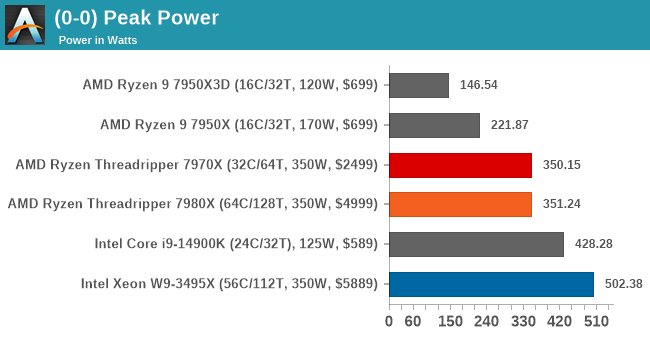
Looking at the max power we observed on the AMD Ryzen Threadripper 7980X and 7970X processors, we can see they hit and don't go robustly above their rated TDPs of 350 W. In contrast, the Intel Xeon W9-3495X peaked at a huge 502 W, well above the rated 350 W TDP. Compared to the desktop processors we've added to the data set, both Threadripper 7000 series processors are also considerably below the Intel Core i9-14900K.
Moving onto a deeper look at how the AMD Ryzen Threadripper 7980X compares to the Intel Xeon W9-3495X in Prime95 with Small FFTs, we can see that Intel's Sapphire Rapids WS option draws considerably more power. Despite having eight more cores than the W9-3495X, the Threadripper 7980X runs consistently within AMD's designated TDP of 350W; this is the TDP for all three AMD Ryzen Threadripper 7000 series SKUs. As we've highlighted in our desktop reviews of the Ryzen 9 7950X and Ryzen 9 7950X3D processors, we know AMD's Zen 4 core doesn't only deliver in performance, but it's a highly efficient core, too.
Compile/Database
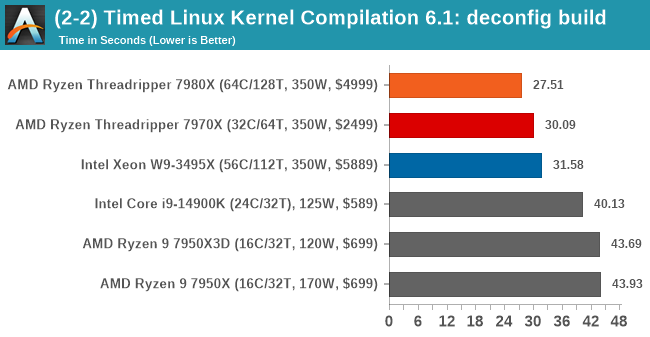
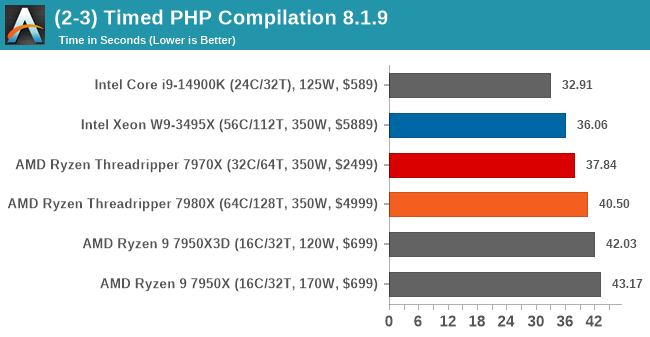
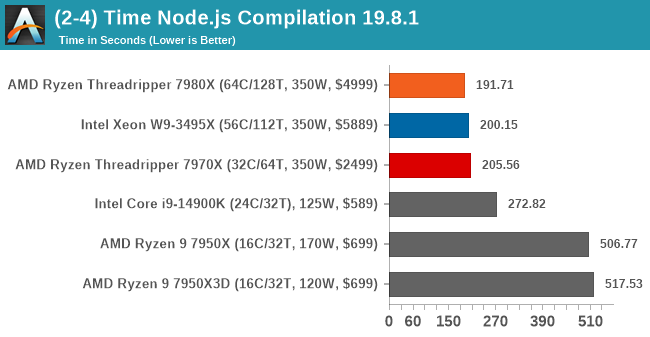
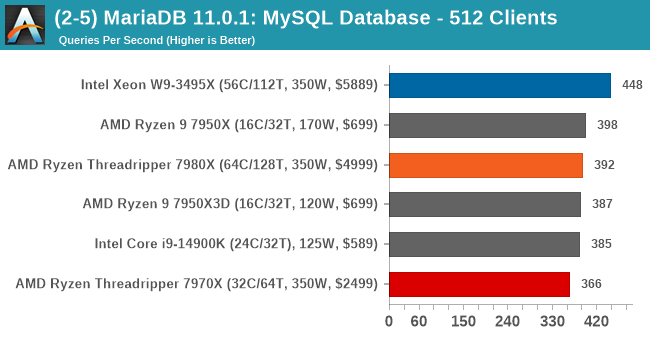
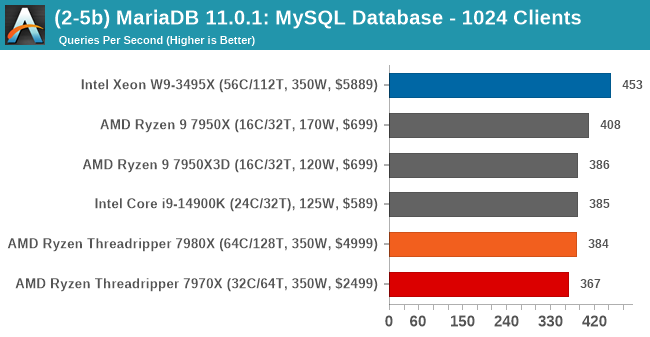
In our timed compilation benchmarks, including Linux Kernel, PHP, and Node.js, we can see that the Threadripper 7980X and 7970X perform well for the most part. In larger compilations such as Node.js, there's a significant advantage to having a higher core/thread count. Intel's Xeon W9-3495X beats all the chips we tested convincingly in the MariaDB MySQL database benchmark, with the flagship desktop chips also performing well here.


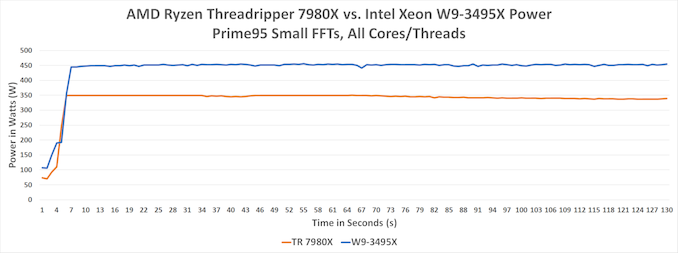








66 Comments
View All Comments
Jansen - Monday, November 20, 2023 - link
Bit disappointing that the memory controller only supports DDR5-5200, considering that JEDEC compliant DDR5-6400 RDIMMs are available.Ryan Smith - Monday, November 20, 2023 - link
At the end of the day it's the same I/O die as Genoa. So it comes with roughly the same restrictions.TEAMSWITCHER - Monday, November 20, 2023 - link
Not surprised by this at all. My 3960X Threadripper system was never able to run 64gb (16gb x 4) at even the promised DDR4-3200 speed. I tried three different RAM kits and even a different CPU (replaced by AMD) and the problem never went away. In the end I believe it to be motherboard issue, it was simply incapable of running stable with any RAM faster than DDR-3000.After spending so much on the ASUS Zenith II Extreme Alpha motherboard, 64GB of DDR-3600 RAM, and a $1400 CPU, the end result was very disappointing. Support from ASUS, AMD, and G-Skill was a long process, and eventually I had to just accept what was working and move on.
Ultimately, I don't believe that AMD and ASUS can properly deliver and support any HEDT platform that is worth the money they ask for it. I sincerely wish Intel would return to this segment, as I never had a problem with my X99 Deluxe II motherboard.
lemans24 - Monday, November 20, 2023 - link
Intel is definitely in HEDT with their xeon w-2400 chipsStormyParis - Monday, November 20, 2023 - link
I've blacklisted Asus. Lots of issues with both specs, reliability, and service.vfridman - Monday, November 20, 2023 - link
I have two systems with 3990X and two systems with 3970X, ASUS Zenith II Extreme Alpha motherboard and 256GB of 3600 speed G.Skill RAM in each system. All runs perfectly and completely stable, even with maxed out PBO overclock. I regularly run compilation jobs that require almost entire 256GB of RAM and never experienced any problems. I suspect you got unlucky with your CPU memory controller.Mikewind Dale - Tuesday, November 21, 2023 - link
I have a ThreadRipper Pro 3950X on a Supermicro WRX80 motherboard. I run 8x64 (512) GB of Supermicro-branded DDR4 3200 ECC RDIMM without a problem.Adam7288 - Wednesday, November 22, 2023 - link
Same exact config! Ram Bros.tygrus - Saturday, January 6, 2024 - link
How are you going with those >200GB matrices & statistics?Many years ago I had to use raw frequency stats, then a program to generate blocks of SAS code that could analyse cross-tab by cluster (weighted) with smaller subsets of interest from every possible combination (multi-morbidity data). Making sure the stats methods still gave correct results. Divide & conquer to fit in limited RAM of circa 2013 computers. In those days it was mostly constrained by single thread & disk/network IO speed (~100MB/s).
TEAMSWITCHER - Friday, November 24, 2023 - link
Ya know.. I have yet to build an AMD system that didn't suffer from some kind of issue. I don't think I'm unlucky either. I need to stop buying AMD gear thinking... "this time will be different." Because it never is.